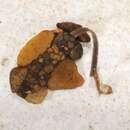Brief Summary
provided by Catalog of Hymenoptera in America North of Mexico
This suborder includes a vast and diverse assemblage of species-level taxa, and many more genus- and family-level taxa than does the suborder Symphyta. Other names used in the past for the suborder include Petioliventres or Petiolata, Clistogastra and Heterophaga. Common names applied to the major groups of Apocrita include braconid and ichneumonid wasps, chalcid flies or wasps, gall wasps, ants, true wasps and bees. The first three groups are sometimes placed in the Division Parasitica or Terebrantia, and the latter three in the Division Aculeata. More detailed information is included under the divisional headings. ~There are several important characters separating the Apocrita from the Symphyta. The apparent thorax is separated from the apparent abdomen by a constriction. What appears to be the thorax actually consists of the true thorax to which is fused the first abdominal segment (propodeum); the apparent thorax is sometimes termed the mesosoma or alitrunk. What appears to be the entire abdomen is termed the gaster or metasoma. The venation, especially that of the hind wing, is reduced in size and has fewer veins and cells than in Symphyta. The larvae are maggot-like and apodous; some have fleshy pseudopods on the thorax or abdomen which assist in very limited locomotion but which are not homologous with the thoracic prolegs found in most sawflies. ~The majority of larval Apocrita, including the most primitive, are entomophagous. However, phytophagy has developed independently in many higher groups such as some Chalcidoidea, most Cynipoidea, a few Vespoidea and the Apoidea. ~There are some fifteen times as many Apocrita recorded from North America as Symphyta. However, it is virtually certain that this ratio will be substantially increased in the future when the smaller Parasitica are more thoroughly collected and studied.
- bibliographic citation
- Catalog of Hymenoptera in America North of Mexico. 1979. Prepared cooperatively by specialists on the various groups of Hymenoptera under the direction of Karl V. Krombein and Paul D. Hurd, Jr., Smithsonian Institution, and David R. Smith and B. D. Burks, Systematic Entomology Laboratory, Insect Identification and Beneficial Insect Introduction Institute. Science and Education Administration, United States Department of Agriculture.

